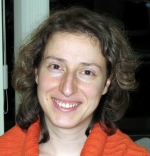Dr Fani Deligianni
 |
Fani Deligianni |
Our paper on Controllable Chest X-Ray Report Generation from Longitudinal Representations, has been accepted at Empirical Methods in Natural Language Processing (EMNLP), 2023.
Our paper on Multi-Scale Cross Contrastive Learning for Semi-Supervised Medical Image Segmentation, has been accepted at BMVC, 2023.
Our paper on Beyond supervised learning for pervasive healthcare, has been accepted at IEEE Reviews in Biomedical Engineering, 2023.
Our paper on Toward Personalized Music-Therapy: A Neurocomputational Modeling Perspective has been accepted at IEEE Pervasive Computing, 2023.
Short Bio & Research Interests
Her research interests are in the field of Healthcare Informatics with emphasis on:
Medical Image Computing,
Statistical machine learning,
Human Motion Analysis with wearable sensors
Neuroimage analysis and Brain Connectivity
Human Machine Interaction
Fani Deligianni holds a PhD in Medical Image Computing (Imperial College London), an MSc in Advanced Computing (Imperial College London), an MSc in Neuroscience (University College London) and a MEng (equivalent) in Electrical and Computer Engineering (Aristotle University, Greece).
Her PhD work was on augmenting 3D reconstructed models of the bronchial tree with 2D video images acquired during bronchoscopy. Bronchial deformation was modeled based on Active Shape Models (ASM) and a predictive tracking algorithm was incorporated to improve tracking of the endoscopic camera.
Fani is also a former member of the Centre for Brain and Cognitive Development (CBCD) at Birkbeck. She worked at CBCD from 2006 to 2008 and she developed a toolbox for contingent eyetracking, Talk2Tobii, to investigate the development of social skills in toddlers. The toolbox is used in several labs and is now integrated in T2T Package and SMART-T.
She has received more than £700k funding from MRC, EPSRC and the Royal Society to develoop machine learning algorithms for the analysis of neurophysiological data as well as human motion data for healthcare applications. She was awarded an MRC Special Research Training Fellowship in Biomedical Informatics to explore links between structural connectivity as it is measured with Diffusion Weighted Imaging (DWI) and functional brain connectivity captured with resting-state (rs)-fMRI. Her research work suggests a prediction framework to study the link between structural brain connectivity and functional brain connectivity. She developed sophisticate computational approaches in machine learning, statistics and network analysis for the investigation of human brain structure and function. She applied her approach in functional data derived from simultaneous resting-state EEG-fMRI and microstructural indices obtained from neurite orientation dispersion and density imaging of the human brain. In particular, she uses graph theory, machine learning and statistics to describe and characterise complex interconnections between multi-modal brain networks. Currently, she holds funding from Royal Society and EPSRC to develop machine learning methods for Privacy-Preserved Human Motion Analysis for Healthcare Applications.
Contact Details
Email: fadelgr at gmail dot com
Twitter: @fd301
ORCID
LinkedIn Profile
WebOfScience Profile
Github Page